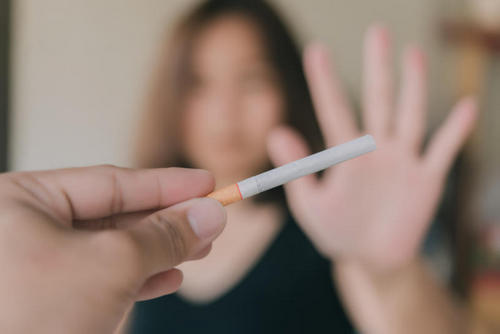There is evidence that together these two methods give the best results – 25–35% of patients successfully quit smoking with the help of combination therapy.
Of those who try to tie cigarettes on their own, only 3-6% quit.
Quitting smoking is difficult, but possible. According to international recommendations, adults who plan to quit smoking are advised to combine pharmacological treatment and behavioral therapy.
Nicotine addiction: why quitting smoking is so difficult
Think you lack willpower? There is nothing to do with willpower – it’s all about the physiology of the brain. When we smoke, nicotine from cigarette smoke enters the lungs, is absorbed into the pulmonary veins, then into the arteries, and from there it enters the brain. There are nicotine sensitive receptors in the brain. In fact, normally the task of these receptors is to control the work of the body, including mood and thinking. But when nicotine enters the business, the brain’s work is not only disturbed, but significantly changes.

Under the influence of nicotine, receptors release dopamine, which is involved in the work of the reward system, glutamate is the main excitatory brain neurotransmitter, and also serotonin, adrenaline and norepinephrine. As a result, after “smoking” for some time it’s easier to think, to concentrate on work tasks, the smoker becomes calmer and more resistant to stress.
One problem: nicotine-sensitive receptors “clog” very quickly and stop responding to stimulation with a cigarette. That is, only the first morning puff is really happy. Then smokers pick up a cigarette, just to avoid nervousness, irritability and an obsessive desire to pause and finally smoke.
The more a person smokes, the sooner a nicotine addiction is formed, and each new cigarette additionally supports the craving for tobacco. In fact, nicotine is built into the system that regulates the functioning of the brain – so firmly that the suffering of a brain devoid of a cigarette is clearly visible on functional magnetic resonance imaging (f-MRI).
Naturally, in such a situation it will be very difficult to quit smoking even for a person with a steel will. After all, in fact, in the fight against nicotine, you have to play against your own brain, which is configured to resist with all its might.
4 main reasons to quit smoking
1. General reduction in mortality
According to ruthless statistics, approximately half of smokers die from tobacco-related diseases. At the same time, it is never too late to quit: there is evidence that quitting smoking reduces mortality even among smokers over 80 years of age.
2. Decrease in mortality from cardiovascular diseases
Tobacco smoking is the cause of more than 10% of deaths from cardiovascular diseases in the world. But in people who quit smoking, the development of such diseases slows down, the risk of a second stroke decreases.
3. Reduce cancer mortality
Mostly, of course, from lung cancer. But the chances of dying from other oncological diseases, such as stomach cancer and ovarian carcinoma, smoking cessation significantly reduces.
4. Improving the appearance and preservation of beauty
The fact that smoking causes cancer and disease, we hear every day, but that’s when it will be. But the change in appearance is literally reflected on the face. Smokers have reduced skin elasticity, so the skin looks unhealthy, old and dry, wrinkles appear on it earlier. Tooth enamel cracks, teeth turn yellow. Bad breath appears. The ability to enjoy the taste of food and distinguish its smell decreases.

If you quit smoking, your health will begin to improve in 20 minutes – if only because the pulse returns to normal. The first positive changes in appearance will become noticeable in 2-12 weeks, because normal blood circulation in the capillaries will be restored. After a year without cigarettes, the risk of developing cardiovascular disease will be halved.
What is withdrawal syndrome and how does it manifest
Now about the problems that have to face. There are so many of these problems that they even have their own special name – withdrawal syndrome.
Here is a short list:
1. Increased appetite and weight gain
Nicotine reduces body weight because it accelerates the destruction of adipose tissue and improves glucose absorption. A smoker weighs on average 4–5 kg less than a non-smoker. So it’s quite possible to get fat after giving up cigarettes – especially for people who tend to overeat to cope with a bad mood.
2. Depressed mood
Sometimes, against the background of withdrawal syndrome, real anhedonia develops – a condition in which a person almost completely loses the ability to enjoy sex, food and other joys. Almost like with clinical depression.
3. Insomnia
Nicotine affects the neurotransmitters that regulate sleep. If you give up cigarettes, it will be difficult for a person to calm down, so it will be difficult to fall asleep for some time.
4. Problems with concentration, irritability, anxiety or anger
We remember that nicotine triggered a reward system and contributed to the release of serotonin, which is responsible for a good mood. Until the receptors return to normal and learn how to release these substances when necessary, and not when you smoke, it will be more difficult to control your mood and control a bad mood.
The good news: withdrawal symptoms are most painful only the first 2-4 weeks after quitting smoking. True, some people are not so lucky, and the symptoms of the acute withdrawal syndrome remain with them longer – for several months. At the same time, half of the people who quit smoking already after 6 months almost did not suffer from withdrawal syndrome.
How to start smoking in science
1. Find a good clinic
The most important thing is to find a good clinic that specializes in quitting smoking, or that has a tobacco dependence treatment program.
2. Find a doctor who has the right to prescribe nicotine replacement therapy
You can’t do without a doctor in this situation, because drugs for nicotine replacement therapy (NRT) are sold only by prescription. According to international recommendations, two drugs are used as the first line of drugs for NRT: varenicline and buproprion, and the latter is not used in our country. A Russian doctor has the right to prescribe only varenicline *.
Even in Russia and other countries of Eastern Europe, they can prescribe the drug cytisine *. Although the US Food and Drug Administration (FDA) or the European Medicines Agency did not evaluate the effectiveness of this drug, it is believed that cytisine can be used as a second-line drug for the treatment of nicotine addiction.
As a supplement to NRT, and in some cases instead of it, the doctor may recommend a combination of two nicotine replacement drugs: a nicotine patch and nicotine chewing gum (or lozenges). These remedies have proven effectiveness.
A key goal of pharmacotherapy is to maintain the level of nicotine in the blood at the same level, without nicotine peaks. Thanks to NRT, the need for nicotine is gradually decreasing, and quitting smoking is becoming easier. It also reduces withdrawal symptoms.
3. Find a psychologist or psychotherapist who has experience with smoking addiction
The specialist will choose the format of behavioral therapy that is right for you. It is more convenient for someone to talk with the therapist face-to-face, while for someone it is easier to quit smoking in company with other patients. At the same time, both individual and group treatment works.
The task of a specialist is to teach a person to independently cope with the problems that will arise during attempts to quit smoking, and to act correctly in situations that cause a desire to smoke. Most often, cognitive-behavioral therapy is used for this purpose and they provide general support – sometimes it is enough to just talk with a throwing person to support him in this decision.
In 2018, Russia adopted new standards for the treatment of tobacco smoking and published clinical recommendations КР601 “Tobacco dependence syndrome, adult tobacco withdrawal syndrome”.
According to new standards, the most ordinary doctors who have almost any clinic in every city have the right to get rid of tobacco dependence. So, not only a psychiatrist or narcologist can prescribe therapy, but also a therapist with a pulmonologist.
According to Russian clinical guidelines, they will be treated in approximately the same way as is usual in Europe and the USA. The tactics of getting rid of addiction will consist of two stages: cognitive-behavioral and pharmacological therapy. The course of treatment will take from three to six months. In severe cases, treatment can last up to a year, if necessary, the doctor will prescribe a second course.
In an interview with the 360 ° Russian Internet publication, psychiatrist-narcologist Evgeny Buchatsky noted that the methodology proposed by the Ministry of Health was no worse and no better than any other method used in the world. In any case, such a scheme will definitely work.
What to learn at the clinic or at the doctor
In the end, it is not so important who exactly you will be treated for.
The main thing is what you should learn at the clinic or from your doctor:
- Recognize the symptoms of withdrawal syndrome and remind yourself that they will pass soon, use the prescribed NRT medication. If you really want to smoke, you can try to chew something low-calorie, such as a carrot or an apple. And if you feel anxiety or anger, walks and exercise will help.
- Identify situations that make you smoke. Most often it is communication with smoking friends or colleagues, parties, breaks at work and just boredom. One must learn to avoid such situations.
- Learn to solve the problems that arise during treatment. Including monitor stressful situations and come up with how to calm down without a cigarette.
- Have patience. All people are different, but most likely, quitting smoking quickly and without problems will not work. Well, it’s okay – in due time everything will turn out.
If you quit smoking does not work
No problem. According to statistics, most people try to quit smoking more than once or twice before it finally succeeds.
About 72% of former smokers could not stand even three months without cigarettes, and 35–40% of patients start smoking again 1–5 years after they quit. But the same studies say that almost two-thirds of those who break away again report a desire to quit within a month.
Couldn’t quit? There’s nothing to blame for, because your own brain failed you. Everything is in order – you just need to continue trying.
Do tobacco heaters help quit smoking
Not. As we already know, NRT is built to maintain a constant level of nicotine in the blood. Unlike tablets and a patch, electronic heaters force a person to receive a dose of nicotine too quickly – in just 3.5-10 minutes. Because of this, the level of nicotine in the blood constantly jumps, and dependence on tobacco only increases.
Throwing is better on a strictly defined day, without delaying the decision. This is much more effective than using heaters or gradually reducing the number of cigarettes smoked. Nevertheless, before you quit, it is still worth consulting a doctor – this will help minimize health risk and discomfort.
What is the result
- Quitting smoking on your own is difficult, because the former smoker has to struggle with his own brain. Weak will have nothing to do with it.
- To really get rid of cigarettes, you need to find a clinic where they carry out complex treatment of nicotine addiction. The clinic should have at least two specialists: a doctor who will prescribe nicotine replacement therapy, and a psychologist (or psychotherapist) who will provide psychological support.
- If you could not quit and lit again – that’s okay. Just keep trying to quit when you recover.
- Tobacco heaters do not help quit smoking.
* This material is not an advertisement for any medicines. Before use, be sure to consult your doctor.



